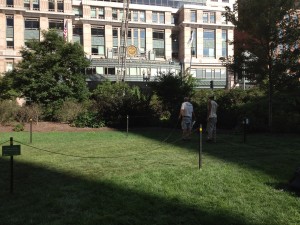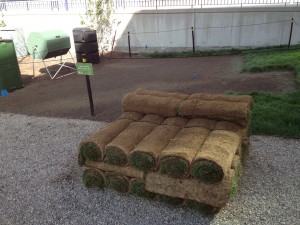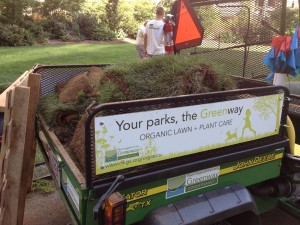During the past week, several sections of turf that had experienced compaction due to rain and then heavy foot traffic were replaced. We spoke with our Superintendent of Horticulture for the Greenway Conservancy, about the process.
Stu, why did you replace turf in several areas along the greenway?
During a big recent event weekend, we had unexpected heavy rains at the end of Saturday, with continued foot traffic on Sunday, resulting in excessive wear and tear in portions of Dewey Square and Fort Point Channel Parks. We aerated and re-seeded the areas. While several areas have shown improvement, other areas were too heavily compacted to recover with just grass seed.
What’s the process for replacement?
We stripped out the damaged turf using a sod cutter, removed it and re-raked the soil to level the area. Then we laid down the sod, rolling it with a hand roller, sprinkling additional grass seed into any gaps and cracks, and watering the sod by hand to get it established.
What happens to the damaged turf as well as extra sod pieces that you couldn’t use?
All damaged turf as well as the small amount of leftover new sod was composted as was the small amount of new sod. Thanks to use of the sod cutter, only 10 square feet of 2,000 square feet of new sod was left over.
Compost? Do you make compost on the greenway?
Sadly, we don’t have a maintenance facility to make compost. Instead, we collect all organic material and each week a vendor collects it for composting off site. We close the carbon loop by purchasing finished compost from the vendor which is applied to our turf and planting area twice a year.
How do you maintain lawns through-out the year?
We use organic practices for maintaining the 15 acres on the Greenway. We aerate the turf areas at least three times a year. We apply compost and humates in both the spring and fall. Finally, we apply organic fertilizer four times a year (April, June, September and November.) This ensures that the turf areas have the right balance of conditions for survival through dry and warm conditions as well as the cooler spring and fall seasons.
Further, each member of our Horticulture staff is Accredited Organic Land Care Professional (AOLCP) accredited by the Northeast Organic Farming Association (NOFA).
How can I find out more about how the Conservancy maintains the greenway?
Visit our Organic Practices page on our website.






